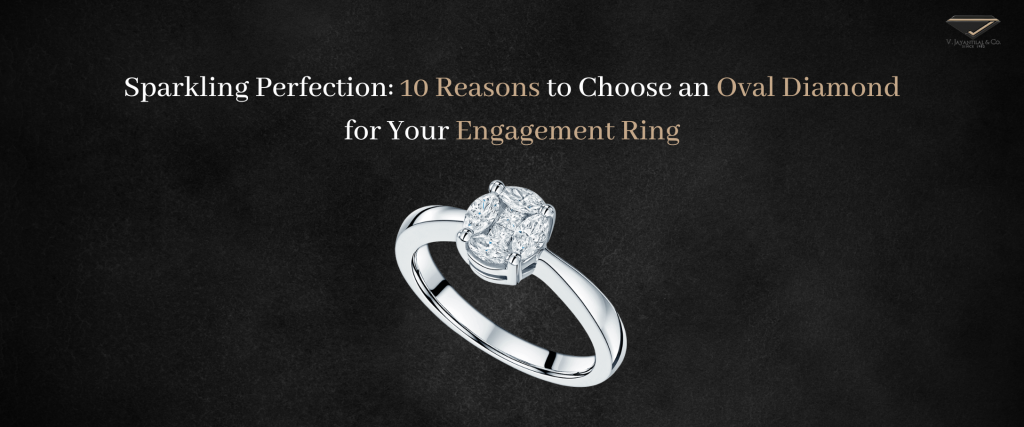
Every couple of years, a new engagement ring form gains popularity, which causes costs to increase owing to great demand. For a number of years, the title has belonged to the oval-shaped diamond engagement ring. In the realm of fine jewellery, the oval ring serves as a steady friend. oval diamond is the second most popular diamond cut after round diamond, it has a mark on day one and continues to be loved by fashion magazines and engagement ring trendsetters. The most extraordinary aspect of this traditional diamond cut is that it flatters every finger type and carat.
So, diamond oval rings are for you if you desire a large, magnificent diamond ring with exceptional brilliance and wonderful glitter! Here is the benefit of buying oval diamond engagement ring:
Oval diamonds are very similar to round diamonds in terms of brilliance and sparkle. However, an oval has a naturally elongated shape that appears more prominently on the finger. Despite having identical carat weights, the oval diamond will take up more space on the ring finger due to its elongated shape. Oval diamonds may be the most costly form on the market right now, but they're a safe and wise approach to buying oval diamond, considering you’ll receive the most for your money.
One thing to keep in mind with an oval diamond is that the color and clarity will stand out more the larger the center stone. Jewellers recommend staying between D and F on the color scale if the oval is 1.00 ct. and up. If you're searching for an eye-clean oval diamond of 1.5 ct and higher, it is advised to stick with VS1-VS2 clarity.
The apparent bow-tie configuration within an oval-cut diamond distinguishes it from other diamond forms. The oval diamond's cut prevents light from bouncing back and forth in the centre, which results in the bow tie effect. The bow tie is one of the numerous characteristics of an oval diamond that make it attractive and unique. However, in order to maintain the oval diamond's uniqueness, you must be attentive while selecting the setting. Even though an oval-cut diamond combines well with most settings, the inappropriate setting can wind up overpowering and outshining the centre stone. An oval diamond looks lovely in a halo setting, a prong setting, or a bezel setting.
Oval-cut diamonds are more unique than round-cut ones and are surprisingly cheaper. The cost climbs by a few thousand dollars every time you raise the carat size. An oval diamond cut gives the illusion of a larger cut stone—without the added cost. If you want to buy engagement ring for woman use the extra money to plan your ideal honeymoon. In actuality, the diamond's elongated oval form deceives the eye into perceiving more. Therefore, an oval diamond ring appears much bigger than a round diamond that weighs the same.
Everyone aspires to have long, graceful fingers, but some of us are just not so blessed. The oval shape of the diamond might give the appearance of longer, slimmer fingers on women if you're trying to trim down. When you are wearing an oval-cut diamond, this is not a problem. The curve of the ring organically elongates your fingers, giving you that desired gracefulness. Before making a decision, always try various stone shapes to make sure the ring's form suits your finger.
An oval-shaped diamond is versatile in that it pairs well with most settings. choosing the right setting is almost as crucial as picking the center stone. The improper setting may overwhelm and outshine the central stone. Here are some examples of previous oval diamond settings that past clients of Diamond Mansion have opted for. Some popular settings for oval diamonds include the solitaire, halo, and three-stone settings. The solitaire setting is a classic and timeless choice, while the halo setting adds extra sparkle and emphasizes the oval shape.
It might be difficult to choose the ideal diamond because they come in a variety of cuts, styles, and sizes. The stunning traditional cuts of round and princess diamonds are very well-liked. In fact, they are a touch too famous, causing them to lose their distinctiveness. An oval-cut diamond, on the other hand, is a spectacularly unique stone that will undoubtedly draw people's attention. For those seeking some diversity, the standard oval diamond shape is a timeless classic and elegant option.
When it comes to oval engagement ring designs, you can employ a concealed halo, a three-stone setting, or encircle your oval stone with hundreds of accent diamonds. If you want to make your love gift more unique, choose an oval diamond cut ring. If your perfect engagement ring only exists in your mind, contact us today so we can make it a reality.
Celebrities are known for living lavish lifestyles. Proposals and engagement rings are no exception. Oval diamonds gained appeal, according to some, when Blake Lively's longtime husband, Ryan Reynolds, proposed to her with a 12-carat pink oval diamond engagement ring. The ring, which Lorraine Schwartz created, is valued at $2 million.
Any diamond with sharp corners is likely to catch on surfaces while you are performing routine tasks, increasing the risk of breaking the prongs that hold the stone in place. A square-cut diamond's prongs are far more likely to break than those of an oval diamond. Oval diamonds are great practical wear for every day because they have no sharp corners.
The oval engagement ring is more exotic than its round cut, but it still has many of the same advantages as a round stone, including durability. Because there are no sharp edges, an oval cut is difficult to chip, and it's almost impossible when you choose a durable stone, like a diamond.
The most popular diamond form on the market right now is the oval, with round and cushion diamonds coming in second and third, respectively. Everyone has different styles and tastes, especially when it comes to engagement rings and other jewellery. There is no right or wrong answer to which shape to choose. If you can’t decide on just one, ask your jeweller how you can incorporate other shapes of diamonds into your design. However, a diamond oval engagement ring unquestionably gives your partner's hand classic shine.
At V. Jayantilal & Co., we design and customizes the engagement ring of your dreams from scratch. Regardless of the cut, size, and shape, we can help you find an engagement ring that is just right for you! Head over to our website to speak with our experienced ring specialists.
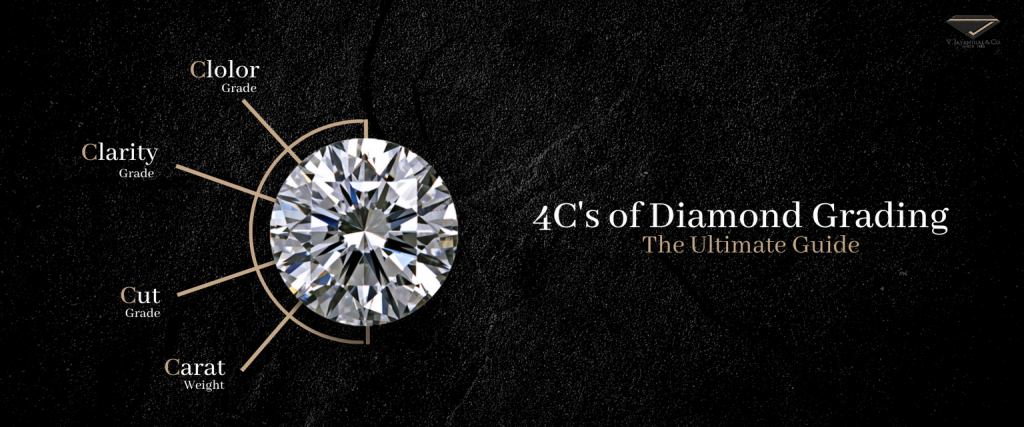
GIA created the 4Cs (Color, Clarity, Cut and Carat) as a global standard method to check diamond quality no matter where in the world. The 4C’s of diamond-cut, color, clarity, and carat – are the widely accepted standard characteristics for a diamond that determines its quality. Based on these attributes, you can evaluate a diamond’s value. Each of the 4Cs plays a vital role in a diamond's beauty. But, selecting just one feature that makes the diamond remarkable is very difficult. The interaction between each of the 4 C’s gives us the ideal shimmering element. In this blog, We'll walk you through the 4C’s of the diamond.
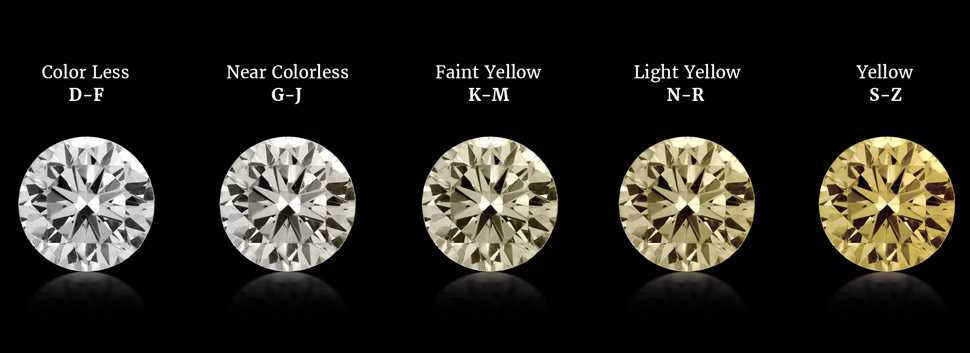
Diamond color is evaluated in terms of how white or colorless a diamond is. It is analyzed based on the lack of color. No hue exists in a pure, structurally flawless diamond. The color grading is based on the lack of color ranging from colorless to yellow, represented by letters from D to Z. Colorless diamonds are the rarest. A diamond with the same structural perfection as a diamond and the same colorlessness as a drop of colourless water is worth more. A diamond's tint is measured using the GIA's D to Z diamond colour grading system, which is used under controlled lighting and by qualified observers. D-colour is the purest, almost colorless and as we go down the color grading scale, diamonds gain a slight tint of yellow or brown color. Most of the time, despite the potential price difference, it is impossible to tell two adjacent colour-graded diamonds apart from the naked eye. However, the minute differences in tint have a significant impact on the value and quality of diamonds. The way a diamond is cut determines how sparkly it will be. Make sure the diamond colour is maintained regardless of the setting and does not obstruct the reflection of white or coloured light before making a purchase of GIA certified diamonds. In contrast to white, colourless diamonds, their natural colors—such as blue, red, and pink—are referred to as "fancy," and their colour grading is distinct. Fancy color diamonds have separate grading protocols. Most individuals are unable to recognise the difference between the two types until they are placed side by side.
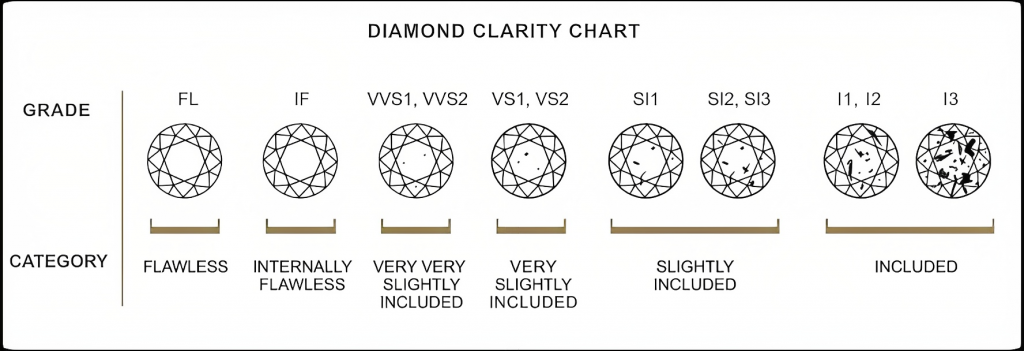
Diamond clarity is the lack of imperfections and blemishes. Diamonds without inclusions or blemishes are rare; however, most qualities may only be observed under 10x magnification. Carbon can be transformed into a diamond by exposing it to extreme heat and pressure. These naturally occurring diamonds are therefore adorned with a variety of internal traits called inclusions and external features called blemishes. The absence of blemishes and inclusions on and in diamonds is what is meant by the term "clarity." The best deals in diamonds are those with a VVS2 or above grade; nonetheless, you shouldn't overvalue the status of a "flawless" diamond. Clarity grades vary from flawless to included, represented by FL to I3. While no diamond is absolutely pure, the closer it gets, the greater its value. The GIA clarity grading scale has 11 specific grades combined into six grading categories. They are:
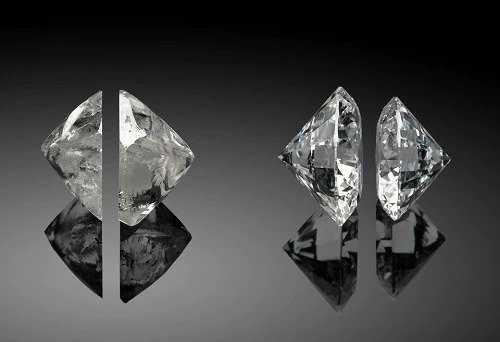
The "cut" of a diamond is probably the most significant aspect of its quality that defines its appeal. More specifically, a diamond's cut grade impacts the ability of the facet to reflect light. The cut grades vary from superior to below average. Fire, scintillation, and brilliance are the three main factors that affect a diamond's sparkle. Fire describes the flashes of colour emitted from a diamond. Scintillation is the term used to describe the light bursts that happen when a moving diamond, light source, or observer is present. Brightness is a combination of pure white light that reflects from the inside and outside of the diamond. The more precisely cut a diamond is, the more eye-catching it is. The ultimate beauty and diamond value are greatly influenced by its cut. Additionally, it is the most complex and technically challenging of the diamond's 4Cs to analyze. The diamond cut is rated as ideal, excellent, very good, good, fair, and poor on the diamonds cut chart. For optimum brilliance and shine, precise workmanship is required for the ideal proportions and angles. It is important to remember that a high rating on the diamond cut table, such as "excellent," does not always translate into an exceptional diamond cut. Excellent cuts make up over 55% of all diamonds sold online. Some are amazing, while others are ordinary.
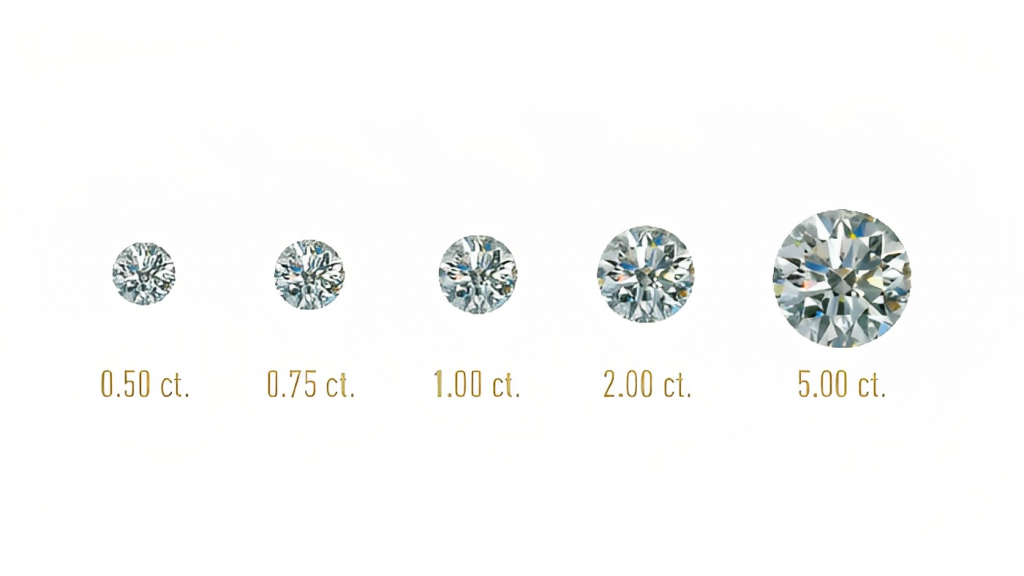
Often when people hear the term “carat weight,” they frequently assume it relates to the diamond's size. In actuality, Carat refers to the weight of the diamond, not how large the gem is. A diamond weighing 1 carat weighs 200 milligrammes. However, the carat size may vary depending on the diamond's shape and cut. A jeweller may use a diamond's 'points' to determine its weight if it is less than one carat. Each carat can be subdivided into 100 ‘points.’ The most objective of the 4Cs is the carat weight. But depending on the other three 4Cs—clarity, colour, and cut—two diamonds of the same carat weight can have very different values (and costs).
Now that we are aware of the 4 Cs of diamond grading, what should be thought about is: what do diamantaires consider the best of the 4 Cs?
All four characteristics are essential in determining how flawless the diamond is. Not one factor can be ignored or given more importance than another. The 4Cs work simultaneously to make a diamond brilliant.
We at V. Jayantilal & Co., sell IGI and GIA certified diamonds to our customers and have followed all the 4Cs of the Diamond Scale.

If you are not a diamond person or do not know enough about diamonds, it might get difficult for you to differentiate between a real and a fake diamond. A girl's world could crumble around her if the stone turns out to be a fake, and you don't know how to tell if a diamond is real. The knowledge needed to detect a fake diamond seems like something only a professional gemologist or jeweller would or should need to know. Diamond purchases stand out from all other purchases you will ever make. You are buying a rare commodity that is in high demand and can go for very steep prices. To prevent such a horrible scenario, you need to take precautions and become educated in regard to markers pointing at a true diamond. So we decided to list a few possible guidelines. Here is how to spot fake diamonds:

A quick and easy way to tell if your diamond is real or fake is by doing a fog test. The fog test is an easy method to determine whether a diamond is genuine or not. One can observe the stone fog up quickly by exhaling on it. You might be able to tell whether a stone is real or fake just by breathing on it because a fake one won't be able to absorb heat. To fog the diamond, position it in front of your mouth as you would your glasses before cleaning them. If the fog or moisture stays on the surface of the diamond for a long time, it’s probably fake. Real diamonds disperse heat very quickly, almost instantaneously, so they do not stay foggy for too long. Make sure your diamond is clean and free of oil before performing this test. Additionally, diamond jewellery cannot be used for this test; only loose diamonds can be used.

The water test is a quick and simple way to check a diamond's authenticity. This is the easiest way to find out if your diamond is real. To use this test, Get a glass full of water at room temperature, and carefully drop the loose diamond into the glass. The gemstone is a real diamond if it sinks. If it floats underneath or at the water's surface, you have a fake on your hands. Diamonds sink in water because they are heavy and made of dense elements. Fake diamonds, on the other hand, are typically created using lighter substances like quartz or cubic zirconia and will therefore float. You might want to use a different strategy here because not all fake diamonds float in water. Additionally, when submerged in cold water, the diamond ought to capture air bubbles. Any floating object without the strong surface tension that draws air bubbles into diamonds is probably a fake. This test determines the density of your diamond.

The sparkle test is one of the most common methods for determining whether a diamond is real or fake. A fake diamond might appear dull or a little blurry, while a real diamond will reflect light uniquely and brilliantly from every angle. Quartz and glass, which can't imitate the sparkle of a real diamond, are frequently used to make fake diamonds. The only equipment needed for the sparkle test is your eyes. Hold the diamond up to the light and move it around at various angles while observing the sparkles and brightness it emits to perform the sparkle test. A real diamond provides exceptional sparkle since it reflects white light extremely well. If it doesn’t have a unique sparkle and appears dull, it’s probably a fake diamond. It's important to keep in mind that none of these imitation diamond materials compare to real diamonds in terms of strength, clarity, or durability. Compared to stone-like cubic zirconia, you'll be able to see a huge difference in the white and colored light sparkle. A cubic zirconia gives off a noticeable rainbow of light. However, it is advised that you don't use this as your only testing method, so try and use the other methods highlighted here.

Also known as the thermal conductivity probe or the diamond tester tool. This diamond lighter test is used to determine the thermal conductivity of a gemstone. It measures the rate at which a diamond disperses heat. True diamonds are excellent heat conductors, allowing heat to be dissipated quickly and uniformly throughout the gemstone. Conversely, false diamonds cannot disperse heat as effectively, thus revealing noticeable hotspots when the heat source is removed. Real diamonds will disperse heat quickly after being warmed, whereas fake diamonds release heat at a slower rate. If the diamond is real, it should quickly return to its initial temperature without any unevenness after being gently touched with a heated needle or lighter for several seconds. If hotspots are discernible, the diamond is most likely phony. It's important to note that this test is inconclusive with moissanite because synthetic moissanite stones frequently have heat dispersion that is comparable to or equal to that of genuine diamonds.There are many different diamond testers out there, so pick the one you like the most.

The UV fluorescence test is an intriguing way to tell real diamonds from fakes when determining whether a diamond is real in another way. Genuine diamonds emit an electric blue hue when exposed to UV light, while fake ones do not. But not all diamonds emit blue light when exposed to UV; some emit other colours instead, such as yellow, orange, red, or green, which can help you distinguish them from other gemstones. It's interesting to note that natural diamonds glow blue more frequently than synthetic ones, making this technique useful for differentiating between the two. Before making assumptions about a diamond's authenticity, one should keep in mind that some diamond treatments can have an impact on their fluorescence, so it is advisable to consult an expert. Overall, the UV fluorescence test is a simple and quick procedure that doesn't call for any specialised tools or knowledge. It is best to have a diamond specialist or jeweller use their sophisticated equipment to test the stone because this test is not conclusive.
When looking for diamonds, especially GIA Certified Diamonds, it’s crucial to be aware of the possibility of purchasing counterfeit items. You can prevent being duped by carefully inspecting a diamond using various tests, such as weighing it on scales or looking for flaws under a loupe. However, the best way to ensure that you are buying a genuine diamond is to purchase one that comes with a GIA certification. GIA Certified Diamonds have been thoroughly evaluated by the Gemological Institute of America (GIA), a respected authority in the diamond industry, and their quality has been verified. When you buy a GIA Certified Diamond, you can be confident that you are getting a genuine and high-quality diamond.
A good jeweller is a key to not getting cheated when buying diamonds. With V. Jayantilal & Co., finding the right jeweller is a breeze. Our authentic algorithm connects enthusiastic buyers with reliable jewellers. Diamond shopping just became super simple. Your perfect diamond is only a click away.
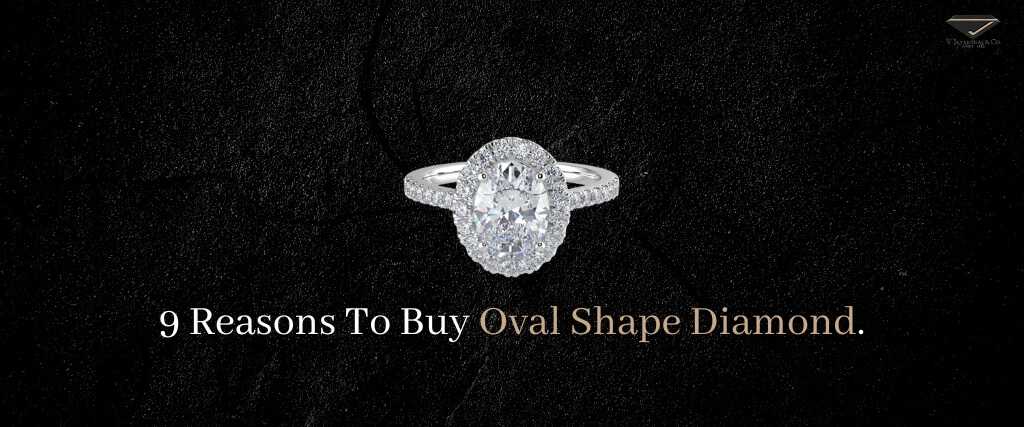
Every few years, a new diamond shape gains popularity, but oval diamonds have maintained their pristine image as one of the most classic shapes. The best thing about this conventional diamond cut is how well it suits all finger types and carats. The round cut of a diamond is modified in an oval diamond ring. That honour belongs to the oval-shaped diamond engagement ring, which has held it for some time.The best four- or six-prong setting for the most brilliant oval cut diamonds is used in the traditional and fashionable oval cut engagement ring. Here are reasons to choose an oval diamond:
An oval-shape diamond extends the popular round or radiant-cut diamond's classic and traditional vibe while maintaining its uniqueness. An oval-cut diamond is a brilliantly unique stone that will draw people’s attention. Ovals are variations on round shapes, so they still have the same number of facets, sparkle, and brilliance, but there is much more variation in their overall proportions.
Oval cuts have been around for centuries, but later on, the modern oval-cut diamond came onto the market. This cut, which was developed by Russian master diamond cutter Lazare Kaplan, extends the conventional round shape while keeping the rounded edge for greater durability than shapes with sharp corners. This traditional diamond cut is a classic and classy choice that appeals to those looking for a bit of variety. This makes an oval-shape diamond perfect for daily wear in an engagement ring and ideal for people who lead active lifestyles. On thick fingers or small hands, an oval shape looks especially lovely because it helps create the appearance of greater length.
An oval-cut engagement ring represents more than just the love, romance, and dedication of a single relationship. It represents uniqueness and individuality, as well as pushing boundaries while still upholding and honouring tradition. This shape also represents fertility, rebirth, and family because it resembles an egg shape. This can be perfect for a couple who wants to start a family together or who wants to commit to a new relationship again after getting engaged, getting married, or breaking up in the past.
The proportions of an oval-cut diamond or gemstone can vary greatly depending on personal preference. An oval-shaped stone's surface area increases with a more extended cut, giving the impression that it weighs more carats and making it more visually striking than other stone shapes of the same size. However, there are "longer," "flatter," and "shorter" oval shapes available, so the selection of stone shapes is largely a matter of taste.
The oval diamond is known for its unique bow-tie formation. It not only makes the diamond look stunning but also enhances its visibility within the ring. The bow-tie effect is caused when light isn’t directly reflected in the diamond's centre. The bow tie blocks the light from returning to your eye because of the diamond's cut. As a result, the diamond's table exhibits a shadow. So the more you focus intently on the stone, you will see a shadowy reflection of your head and shoulders that blocks light from the diamond. If the effect is minimal, the diamond is cut well, but you will always notice a subtle bow tie effect when you’re in front of the diamond.
Oval diamonds are also ideal because of their versatility, which allows them to be paired with most settings. Choosing the right setting is almost as important as choosing the centre stone for your ring. The centre stone can be overshadowed and outshone by the wrong setting. However, you need to be careful when selecting the setting of the oval diamond to maintain its uniqueness. A halo or three stone setting will beautifully and naturally complement the oval diamond, while a solitaire Tiffany ring will draw attention to the oval diamond's fire and clarity.
Oval cut diamonds are more affordable and distinctive than round cut diamonds. For those on a tight budget who want to maximise their purchase, a solitaire oval engagement ring is the best option! An oval diamond engagement ring offers more sparkle and weight at a lower price compared to other diamond cuts. In actuality, the diamond's elongated oval shape deceives the eye into seeing more. Because of this, a round diamond that weighs the same as an oval diamond set in an engagement ring looks much larger.
The oval cut ring's appealing curves inspire harmony and completion while also fostering connections and a sense of community. This has a romantic meaning for couples who “complete” one another and are finding their connections together. An oval's modified circle also represents eternity, making it the ideal shape for an engagement ring's eternal promise.
Celebrities are known for living a lavish lifestyle. Proposals and engagement rings are no exception. Many royals and celebrities have chosen oval shapes for their engagement rings because of the lovely designs of oval engagement rings. Blake Lively, Katie Holmes, Julianne Hough, Serena Williams, and Hailey Baldwin have all opted for different engagement rings featuring oval centre stones, as have the Duchess of Cambridge, Catherine Middleton, and Princess Eugenie of York. Ryan Reynolds, Blake Lively’s longtime husband, is often credited with the rise in popularity of oval diamonds when he proposed a 12-carat pink oval diamond engagement ring. Oval engagement rings give any future bride a touch of high society glamour because so many famous people favour oval-shaped gems.
Overall, it is impossible to ignore the elegance of oval diamonds. They make your jewellery exceptionally elegant, adding a touch of timelessness. Oval diamonds are a unique and ideal choice for your engagement ring because of their exceptional qualities. If you can’t decide on just one, ask your jeweller how you can incorporate another shape of diamond into your design.
At V.Jayantilal & Co., we design and customize the engagement ring of your dreams. Regardless of the cut, size, and shape, we help you find an engagement ring that is just right for you at an affordable price range!